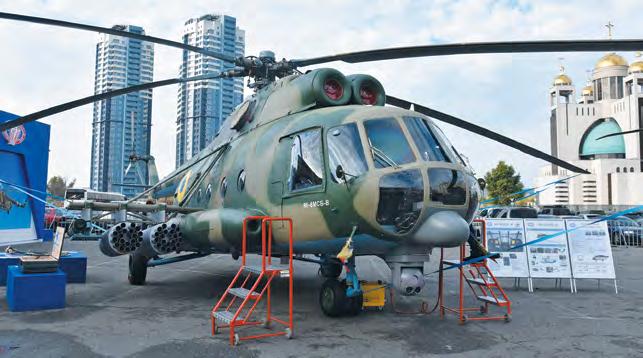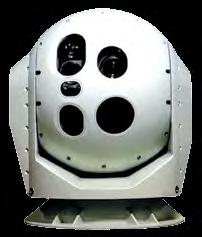
6 minute read
New capabilities
Mi-seri es helicopt er upgr a es
kraine’ Military oi ed to ield an ttack elicopter
Advertisement
with ull ay/ ight and dver e eather apabilitie T he Ukrainian military has long dreamed of having a gunship and attack helicopter platform equipped for precision-guided air-to-ground missions and for Day/Night battlefield surveillance and missile guidance and launching roles enabled with state-of-the-art thermal imaging, electro-optical and laser homing capabilities. Ukrainian industries, among them privately-run Ramzai and government-run State KB Luch, NVK Photoprylad and Izium Instrument Factory, which are affiliates of the State Defense Industries Group Ukroboronprom, already have on offer certain solutions that hold a promise to get this dream into reality. Ramzai, Luch, Photoprylad and Izium Instrument Factory have collaboratively developed an all-weather capable missile fire-control kit, codenamed 524R, which is designed as part of an upgrade to the helicopters Mi-24, Mi-8, and Mi-2.
The 524R has been developed with day-and-night capabilities for

Optronic sensor turret PM LKT Spectrum can identify a tank-size target at ranges no less than 8,000 m in day-time and beyond 6,000 m at night. With laser-assisted guidance, the missile aiming range is between 50 and 7,500 m, with a CEP not exceeding 0.8 m whatever the aiming distance is. (1) battlefield surveillance; (2) search, detection, identification and automatic tracking of ground and aerial targets, moving or stationary, and (3) guidance and control of helicopter-launched, RK-2V missiles. When configured to operate with the RK-2V missile, the 524R supports the detection and identification of tank-size targets at up to 10 km range, allowing the missile to engage targets at ranges up to 7.5 km.
The helicopters are proposed to be upgraded with Photoprylad’s gimbaled optronic sensor turret, the PM LKT Spectrum that can identify a tank-size target at ranges no less than 8,000 m in day-time and beyond 6,000 m at night. With laser-assisted guidance, the missile aiming range is between 50 and 7,500 m, with a CEP not exceeding 0.8 m whatever the aiming distance is.
Izium Instrument Factory and KB Luch are attached to the PM LKT Spectrum project as developers of the laser guidance capability and the RK-2V/ Barrier-V ATGM and launcher, respectively. It must be noted for that matter that the RK2V/Barrier-V features in the attack helicopters Mi-24 that Ukraine had overhauled and upgraded for the Armed Forces of Azerbaijan in 2010-2011. In Azerbaijani service, the helicopters received the designation Mi-24G (where "G" - Gecə, stands for "night" in Azerbaijani). The overhaul/upgrade had been performed by Aircraft Repair Plant Aviacon and KB Luch. The South African company Advanced Technology and Engineering assisted in the project by supplying gyro-stabilized electro-optical systems for surveillance and weapon aiming.
The helicopters received high praise from the Azerbaijani pilots, most particularly for the performance of their night operation and Barrier-V ATGM capabilities, with approximately 30 RK-2V missile launches performed by the Azerbaijani military over the period from 2011. The Azerbaijani Customer has been definitely satisfied with the job well done, but even more so have been the Ukrainian contractors, because it is that contract that has brought Ukraine closer to having an indigenously developed guided weapons capability for helicopters. The solutions created as part of this experience have again been offered for adoption by the Ukrainian military, whose helicopters are lacking the capabilities for night and adverse weather operations and are poorly equipped for combat. Unlike the collaborative project with the SAR and the terminated project involving Sagem, France (which was supposed to equip Ukraine’s Mi-24PU2 upgrade prototypes with Sagem Euroflir 410 day/night gyrostabilized optronic pod integrated with the LKK-V laser sensor for guiding the RK-2V missile), the missile fire-control kit 524R has been developed with reliance on domestic technologies and emphasis on domestic collaborations in Ukraine. "The 524R is fully indigenously designed and built, excepting thermal imaging camera sensors that are the only foreign imported components", the developers have emphasized.
Along with four anti-tank guided missiles (ATGMs) RK-2V, the 524R can support launches of the unguided missiles S-5/8, as well as air-launched bombs and the Unified Gun Pod UPK232-250.
The 524R has already gone through the initial live-fire flight tests that involved missile launches against simulated tank and timber-and-sand fortification targets.
All the highest military officials involved, including the Minister of Defense and Chief of the General Staff have endorsed a document that outlines the process for conducting official qualifications trials leading up to the 524R’s induction into the military. The 524R is expected to be ready for entering the official qualification trials in the near-term future, to be followed by user evaluation and the adoption for military service.
At the 16th edition of the International Expo Arms & Security, held in Kyiv from October 8 to 11, 2019, Izium Instrument Factory (an Ukroboronprom’s affiliate) unveiled the first release of its new-gen optronic weapon aiming pod OPSN-1 which it developed collaboratively with KB Luch. Equipped with high-fidelity EO/Thermal Imaging camera sensors, a laser sensor for guiding ATGMs and a laser range finder, the OPSN-1 supports target detection and provides precision guidance to its →

associated weapons. It is suitable to be mounted and used on a varied range of military platforms, including light armored and armored fighting vehicles, UAVs, helicopters and shipboard gun fire-control systems. With its Thermal Imaging capability, it can detect targets at ranges of 14,500 m or longer and identify them at ranges beyond 6,000 m. Its Laser Range Finder can measure distances ranging between 150 m and 15,000 m, and with laser-assisted guidance, the ATGM aiming range is between 50 and 7,500 m.
The OPSN-1 was showcased at presentation/exhibition of scientific-technical projects and technologies

Mi-8 MSB-V Arm e and Dang erou s
The Mi-8MSB-V helicopter can be fitted with a diversified range of weapons, including bombs, small caliber firearms and missiles. On outer hardpoints there can be mounted bombs or incendiary clusters. The helicopter’s arsenal of small caliber firearms contains Unified Gun Pods UPK-23-250 armed with GSh-23L guns for air-to-ground and air-to-air missions. There are 4 x 12.7 mm machineguns, 8 x 7.62 mm GShG machineguns, and 4 x AG-18A grenade launchers hosted in the outer pods. The armaments package also includes B8V8MSB/B8V20MSB4 packs of unguided missiles S-8. Finally, what makes the MSB-V special is the guided missile fire-control system 524R associated with the RK-2V/ Barrier-V ATGM and launcher.
developed by the Ukrainian Academy of Sciences’ institutions, held in honor of the 100th foundation anniversary of the Ukrainian Academy of Sciences and titled "Science for National Security and Defense". The OPSN-1 technology is now almost fully matured and ready to be finally brought to practical implementation.
The 524R and OPSN-1 are both likely to be capable of supporting control of the new air-launched missile RK-10 that made its debut at the Arms & Security 2019 Expo. Developed by KB Luch (an Ukroboronprom’s affiliate), it is intended to defeat and destroy ground targets protected with explosive reactive armor (ERA), moving or stationary, as well as small surface combatants and slow-moving aerial targets. The RK-10 uses automatic laser beam riding guidance and will be compatible with current helicopter-launched precision-guided weapon systems. The missile’s tandem-charge HEAT warhead can penetrate 1,100 mm of core armor behind ERA. The 38-kg missile can reach ranges up to 10,000 m. It is packaged in a transport-and-launch canister that weighs 62 kg when loaded.
As seen from the above, Ukraine has a great potential to create new technologies for military weapons and equipment, and armed services, both in Ukraine and beyond, have a real opportunity to modernize and upgrade their respective helicopter fleets by adding current-generation technology solutions.










